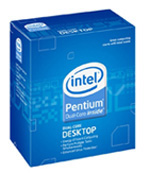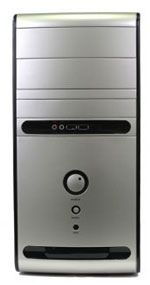Intel Entry-level PC
While Intel still owns the top in the CPU performance, the area from entry to upper midrange is very competitive between Intel and AMD. As pointed out in our Phenom II Guide, the only area still dominated by Intel is the very top, with CPUs at $300 and more. The one advantage that remains for Intel is that their processors generally overclock much better than current AMD CPUs, but that has changed with Phenom II in the midrange. This is not normally a consideration in entry computers, but it could be for some buyers, and at the lowest rungs of the CPU ladder Intel processors remain the best overclockers for now.
| Intel Entry-level PC | ||
| Hardware | Component | Price |
| Processor | Intel Pentium Dual-Core E5200 Wolfdale (2.5GHzx2 65W 2MB L2 800 FSB) |
$73 |
| Cooling | CPU Retail HSF | $- |
| Video | On-Board | $- |
| Motherboard | ECS GF7100PVT-MT NVIDIA GeForce 7100 HMDI | $60 |
| Memory | G.Skill 4GB (2x2GB) DDR2-800 | $37 |
| Hard Drive | WD Caviar GP WD5000AACS 500GB | $59 |
| Optical Drive | Samsung 22X DVDRW/DL SH-S223Q | $25 |
| Audio | On-Board | $- |
| Case | HEC 6K28BSOH48D Micro ATX Mini Tower 485W Power Supply | $50 |
| Power Supply | Included with Case | $- |
| Base System Total | $304 | |
| Display | Hanns-G HB-175APB Black 17" 8ms Widescreen LCD Monitor Built in Speakers - Retail (1440x900) | $99 |
| Speakers | Built-in Monitor | $- |
| Input | Microsoft CA9-00001 Black PS/2 Standard Keyboard and Optical USB/PS2 Mouse - OEM | $16 |
| Operating System | Microsoft Vista Home Premium OEM | $99 |
| Complete System Bottom Line | $518 | |
 |
Our choice for the Intel entry CPU remains the excellent 2.5GHz dual-core E5200 Wolfdale. This 65W rated CPU is built on Intel's 45nm manufacturing that begs you to overclock. The E5200 is rated 800FSB, so right out of the box the first option for overclock, if you are inclined, is to bump it up to a 1066 bus. Even if you never overclock you will be very pleased with the performance of the E5200. The E5200 is an easier choice now that the price is $10 lower at $73 than it was just three months ago. We do not recommend going lower than an E5200 in an Intel system because the trade-offs in performance for the few dollars saved are too great. The E1200 at $50, for example, is dismal compared to the E5200, and certainly not a good choice in performance for the $23 saved.
 |
Unfortunately our favorite Zotac N73PV-Supreme board has been discontinued by Zotac. This was a real surprise considering how well the $60 board sold. The NVIDIA 7100 used in the Zotac is a good chipset choice for an entry Intel 775, so we have chosen the ECS GF7100PVT-MT at the same $60 for the entry Intel system. There is currently a $10 rebate that lowers the price to $50. The ECS provides HDMI output with a DVI to HDMI adapter. If you prefer a real HDMI output on the rear panel you can choose the Gigabyte GA-73PVM-S2H LGA at $69.
 |
The case for the Intel entry system is the solid HEC 6K28BSOH48D Micro ATX mini-tower. HEC is best known as a manufacturer of power supplies. Some are sold under their name, but most are manufactured for other well known power supply brands. HEC includes a 485W PSU with this attractive mini-tower, which should provide plenty of power for your entry Intel build. If you prefer a mid-tower case HEC uses the same PSU in the $50 HEC 6C60BSOH48. You could also choose the Sigma La Vie Aluminum mid-tower featured in the AMD build on the previous page. The rest of the components are virtually identical to the AMD entry-level system.
If we compare the two entry-level systems, the winner depends on what is of value to you. The Intel system is a bit more powerful, but you can move up to a high-end Athlon 64 X2 or a low-end AMD Phenom X3 for comparable performance at less than $100. The full-size AMD ASRock board offers more flexibility for future graphics expansion, with two x16 PCI-E slots and CrossFire X support. If you are a gamer on a strict budget the AMD entry system offers you more for future graphics expansion. For the typical entry-level PC right now and for what the system is typically used for - internet, office, low-end gaming, and low to mid graphics - you can go either route and be very happy.










66 Comments
View All Comments
JarredWalton - Monday, March 16, 2009 - link
We mentioned the benefits of tri-core for video encoding. Also remember that the latest AMD CPUs are 45nm, while the older non-Phenom chips are dual-core 65nm. I think the tri-core chip may actually be the lower power option at this point - it's certainly not going to be significantly hotter while it will be more powerful. Personally, I'd go for Phenom just to get the updated architecture and other improvements, as the dual-core chips are now based on a design that was state-of-the-art several years back. Until AMD moves the Phenom/K10 base design into dual-core, that will continue to be an advantage of the tri-core and quad-core chips.StormyParis - Monday, March 16, 2009 - link
As you say, it seems AMD has pretty much achieved parity processor-wise, at any given price point except the highest where AMD just really has no product.The MBs for AMD processors are always significantly cheaper than the equivalent for Intel CPUs, which tilts the balance. Why is that ?
Goty - Monday, March 16, 2009 - link
I'm assuming it comes down to the fact that AMD's chipset logic needs to be much less complex than Intel's due to the fact that there is no memory controller. This would allow AMD's chipsets to be smaller, cheaper to manufacture, and cheaper to sell to motherboard makers, thus helping to lower the cost for the end-user.I'm sure this isn't the only reason, seeing as how the actual chipset isn't too expensive either way, but things like the complexity of the PCB needed, the number of surface mount components, etc, probably make up for the rest of it.
just4U - Tuesday, March 17, 2009 - link
Not only that but for the last little while amd has been stuck in the budget bin so alot of the MB's that were popular sellers were in that catagory(manufactuers know whats selling whats not).Jaramin - Monday, March 16, 2009 - link
There are two mistakes in the Intel budget article, in the motherboard section.First, it refers to a E7300 CPU, while the CPU is a E7500. Second, and most important, the motherboard has NO integrated graphics. Either change the mobo, or include an entry level discrete GPU. In any case, you'll have to update the price listing...
mariush - Thursday, March 19, 2009 - link
The AMD Entry Level PC lists:Athlon 64 X2 7750 Kuma 2.7GHz Black Edition (2.7GHzx2 95W 2x512MB L2)
I don't know how they managed to fit 2x 512Megabytes of cache in it...maybe it's KB?
Wesley Fink - Friday, March 20, 2009 - link
Thanks for bringing this to our attention. Now corrected.Wesley Fink - Monday, March 16, 2009 - link
My apologies for the error. We are correcting the error as I type this. The last guide revision did include the Gigabyte GA-E7AUM-DS2H nVidia GeForce 9400, which is a 9400 chipset Integrated Graphics board. However, when it went to post the $120 price and Gigabyte was right, but the description was the non-integrated board from tn\he earlier Budget Guide.The board name and picture are now corrected. The updated description will post shortly.
Jaramin - Monday, March 16, 2009 - link
The price for the motherboard is still wrong. 120$ in the budget system, 135$ in the HTPC, same motherboard.Wesley Fink - Monday, March 16, 2009 - link
You have revealed one of the biggest problems with publishing prices - they change faster than you can post them. We changed the board in the Intel Budget system this morning to the Gigabyte with the nVidia 9400 chipset and used the correct for today $120 price. We had not corrected the Intel HTPS same board which was still showing the previous price of $135. The HTPC price has now been corrected. Hopefully it will remain accurate for a few days.